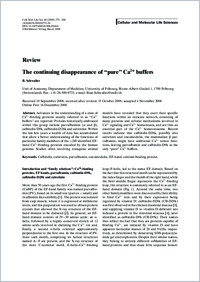The continuing disappearance of “pure” Ca²⁺ buffers
- Schwaller, Beat Unit of Anatomy, Department of Medicine, University of Fribourg, Switzerland
-
21.12.2008
Published in:
- Cellular and Molecular Life Sciences. - 2009, vol. 66, p. 275-300
English
Advances in the understanding of a class of Ca²⁺-binding proteins usually referred to as “Ca²⁺ buffers” are reported. Proteins historically embraced within this group include parvalbumins (α and β), calbindin-D9k, calbindin-D28k and calretinin. Within the last few years a wealth of data has accumulated that allow a better understanding of the functions of particular family members of the >240 identified EF-hand Ca²⁺-binding proteins encoded by the human genome. Studies often involving transgenic animal models have revealed that they exert their specific functions within an intricate network consisting of many proteins and cellular mechanisms involved in Ca²⁺ signaling and Ca²⁺ homeostasis, and are thus an essential part of the Ca²⁺ homeostasome. Recent results indicate that calbindin-D28k, possibly also calretinin and oncomodulin, the mammalian β parvalbumin, might have additional Ca²⁺ sensor functions, leaving parvalbumin and calbindin-D9k as the only “pure” Ca²⁺ buffers.
- Faculty
- Faculté des sciences et de médecine
- Department
- Département de Médecine
- Language
-
- English
- Classification
- Biological sciences
- License
-
License undefined
- Identifiers
-
- RERO DOC 11339
- DOI 10.1007/s00018-008-8564-6
- Persistent URL
- https://folia.unifr.ch/unifr/documents/300897
Statistics
Document views: 139
File downloads:
- Fichier principal: 232
